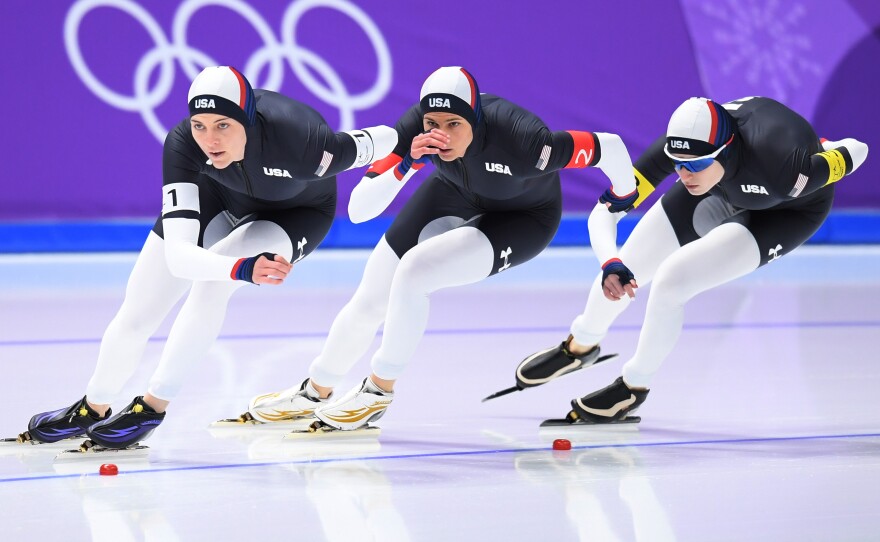When U.S. long track speedskaters Heather Bergsma, Brittany Bowe, Mia Manganello and Carlijn Schoutens won bronze Wednesday in the team pursuit event, they broke a Team USA drought. It was the first long track Olympic medal since the Vancouver Games of 2010.
U.S. speedskaters have always been a dominant force at competitions around the world, including the Olympics. But they performed poorly at the 2014 Sochi Games (some thought their suits might be partly to blame) — and got off to a slow start in Pyeongchang. With Wednesday's bronze, coming after short track skater John-Henry Krueger's silver in the 1,000-meter race on Saturday, hopes have grown for U.S. success at these games.
Before Pyeongchang, the U.S. earned a total of 67 Olympic long track speedskating medals, 29 of them gold. In fact, speedskating has produced more Olympic medals for the U.S. than any other winter sport. American speedskating legends include Eric Heiden, who took home five gold medals in 1980 alone; Bonnie Blair, who earned six medals over her Olympic career; and Dan Jansen, who had a dramatic gold medal victory in Lillehammer, Norway, in 1994.
U.S. successes continued through the early 2000s, as inline skaters came on the long track scene and brought home gold, silver and bronze. The drought began after Vancouver.
But perhaps the speedskaters have turned a corner. Here's a closer look at what it's like for U.S. athletes to compete in this uniquely demanding sport.
Crouching over while skating at 30 mph
Speedskaters have to learn to skate in a deep crouch, balancing their entire weight on a long metal blade that is just 1.1 millimeters thick — about 4/100 of an inch, the thinnest blade of all sports on ice.
The burning pain in the legs and lower back after skating even one lap is enough to dissuade many enthusiasts from trying this sport again, much less clocking in a lap at under 40 seconds.
"It does feel exactly like you're on fire," John Coyle, a short track speedskater who won silver in the 1994 Winter Games, told NPR.
Imagine doing 25 laps crouched over for the 10,000-meter event.
The suits aren't everything
Four years ago, in Sochi, U.S. speedskaters blamed their disappointing performance, in part, on their special skinsuits made by Under Armour. But those who watch the sport closely believe there were a number of other factors affecting performance, including the athletes' worldwide travel schedule to compete at events at various altitudes and their overall fatigue leading up to the Sochi Games.
As soon as the team returned from Sochi, the skaters went back to the drawing board with Under Armour to redesign a suit that would cut out the doubt and give them an edge to win more races.
Together, they came up with the most aerodynamic, lightest, thinnest, most flexible skintight suit they could think of. They tweaked, ran multiple wind tests and came up with a design everyone was happy with well before entering the 2017-2018 season. The skaters have been wearing the new and improved skin suits for the better part of one year (though the suits' crotch-highlighting design has raised eyebrows).
You can't practice at the local rink
To be competitive in long track speedskating at an international level, you have to skate on a 400-meter track every day for at least nine to 10 months out of the year. Building technique and endurance is not achievable by going to the neighborhood skating rink or a nearby frozen pond.
Short track skating opportunities abound in many cities, but there are just a handful of long track ovals in the entire U.S. Two are indoors and are open most of the year; the rest are outdoors and open only during the winter months. The small number of rinks limits the number of people who might want to give the sport a try, much less pursue it seriously.

And that's important, says former Olympic speedskater KC Boutiette, because "people don't know what they're good at until they've tried it."
In 1993, Boutiette moved to Milwaukee to try long track speedskating at the Pettit National Ice Center. Four months later, he earned a spot on the U.S. Olympic team for the 1994 Lillehammer Games, and he went on to compete in the next three Olympics.
Someone who is committed to becoming a U.S. speedskater and getting a chance to compete in the Olympics must do what Boutiette did — move to either Milwaukee or Salt Lake City. The outdoor rinks are in Butte, Mont.; Lake Placid, N.Y.; and Roseville, Minn., but they are not facilities that tend to attract elite skaters.
"That is the break in the system," says Patrick Quinn, a retired U.S. speedskater now with Chicago Sports and Entertainment, a consulting firm that also represents athletes.
A small talent pool
Since the last Winter Games, U.S. Speedskating adjusted its training strategy and travel schedule and invested in building state-of-the-art, data-driven training facilities in Salt Lake City and Milwaukee that closely monitor the athletes' performance and recovery.
In preparation for the Pyeongchang Games, the U.S. Speedskating governing body also moved Olympic trials from the Utah Olympic Oval to the Pettit Center — a strategy that would better prepare the skaters to compete at lower altitudes, mirroring the Gangneung Oval in South Korea.
"U.S. Speedskating is doing everything they can within their power to make these athletes succeed," says Boutiette. "Everyone is doing what they think is the right thing to do so they can be at their best."
Still, "the biggest challenge is lack of depth in the talent pool," says Quinn. "The limited resources at the grass-roots level limits the talent pool that can ultimately get to places where there are amazing facilities to become the best in the world."
To date, the most successful recruitment of U.S. speedskating talent has been among inline skaters. Team USA in Pyeongchang includes six world-class inline skaters turned speedskaters.
But there's starting to be a deficit in that talent pool, too.
"The majority of the new, young inline skaters who are crossing over to the ice have never been to an inline world championship or competed at an elite level," says Derek Parra, who earned multiple world titles as an inline skater before making the transition to ice — and winning silver and gold in the 2002 Salt Lake City Olympics.
He now serves as sports director at the Utah Olympic Legacy Foundation, where he is working closely with U.S. Speedskating on programs to help increase the talent pool with more elite inline skaters. But, he warns, with declining popularity, "the inline talent pool is starting to dry out." The U.S. did not win any medals at the world championship this past fall in Nanjing, China.
Limited public interest and sponsorship
In the U.S., public interest in long track speedskating tends to be at its highest every four years — during the Olympics. Usually, other sports like figure skating, snowboarding and short track speedskating, which are more exciting to watch, attract much more attention.
But indifference during the off years means it's harder to lure sponsors to provide financial support for speedskaters — unlike, say, in the Netherlands, where there are up to eight professional teams and four times as many 400-meter ovals as in the U.S. In Holland, some 80 speedskaters train full time.
"The saying goes, the Dutch get paid on their way to possibly earning a medal and a U.S. skater might get some endorsements after winning a medal," says Parra, who had to work at Home Depot part time to help fund his speedskating expenses while he was training for the Olympics.
"Top 10 is not a failure"
Despite the barriers of entry to the sport, limited funding and the small talent pool, "Our skaters routinely end up in the top 10, which is not bad, given the resources," says Boutiette. "Top 10 is not a failure."
The U.S. team has two long track events left in Pyeongchang. Shani Davis will compete Friday in the men's 1,000-meter race. And on Saturday, all eyes will be on world record holder Joey Mantia, who is set to compete in the Mass Start — a new Olympic event with two dozen speedskaters all pushing and jostling through 16 laps around the track. Mantia has described it as "NASCAR on ice."
Rolando Arrieta, a former inline skater turned long track speedskater, is NPR's news production and operations manager.
Copyright 2022 NPR. To see more, visit https://www.npr.org. 9(MDAzMjM2NDYzMDEyMzc1Njk5NjAxNzY3OQ001))







